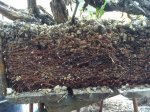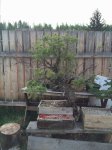It seems to me that any sucking insect working on a tree is going to be at places where the phloem (that carries photosynthate - food for bug and tree alike) is essentially on the surface; leaf veins and petioles and the white tips of roots. The 'bark' is just too thick for their little stylets to pierce elsewhere. Phylloxera is a different bug than the common aphid and infamous for ravaging grape vines. At any rate, root aphids aren't the juicy little guys farmed by ants - a different bug.
The gist of what I've recently learned about phylloxera is that the bug is native to wild grape and pecan trees in the southeast U.S. It is believed to have imported to California from France as a result of an effort to save precious wine making strains before it was discovered that wine grapes can be grafted onto roots stocks that resist phylloxera. It is speculated to have spread from there by cuttings, so marijuana growers don't do cuttings - they grow from seed (or advised to do so).
The first I heard of 'root aphids' was a Bonsai Tonight post. Jonas is within 100 miles of the California vineyards. Problem was with JBP likely raised in the SF area.
@Brian Van Fleet had a problem (weak growth, yellow needles) with a JBP that I think he got from evergreengardenworks.com which is in the same proximity.
@Nybonsai12 thinks he is battling problems with root aphids too.
Now this thread reports that Ryan has had them in Portland, OR. Oregon's vineyards are in the Willamette River valley, less than 100 miles south of his nursery. For everything I have seen, Ryan's collection/stock is exclusively yamadori. So how might his have gotten infested (I ask myself)? Well, Randy Knight also grows stuff as well as collecting all those fabulous yamadori - maybe that is how/why. Michael Hagedorn is in the same area, has some stuff other than yamadori, but hasn't blogged about such problems - maybe it is because he doesn't have any stuff from Randy?
So, I wonder, how your yamadori from the Kootenays could be infested with phylloxera.
I've read that nematodes are the bane of JBP in Japan. I wonder if Jonas' root aphids and BVF's cases weren't really nematodes. Both involved JBP.
It appears to me that the publicity of 'ROOT APHIDS!!' has generated a fad panic - you're just nobody if you haven't had root aphids. Right now, it is hard for me to separate fact from fiction.
I'm not an entomologist.
I don't know what those bugs are in your tree roots.
I've just become interested enough to start educating myself and trying to solve this puzzle to some degree (well, maybe after I do the Sunday crossword).
Best of luck (just in case your trees really are infested with phylloxera).









